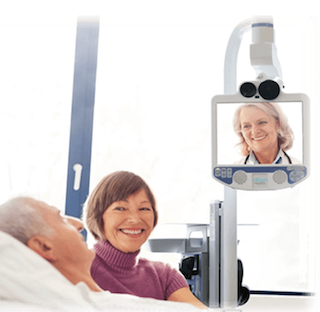 The rush to adopt telemedicine services continues to be a top priority for providers, according to a recent report by New Sage Growth Partners. Fifty-six percent of healthcare leaders surveyed reported that their facilities have implemented telemedicine. While 44 percent of providers are yet to adopt telemedicine in their practice, 86 percent of those who have not adopted it said that telemedicine is a medium to high priority.
The rush to adopt telemedicine services continues to be a top priority for providers, according to a recent report by New Sage Growth Partners. Fifty-six percent of healthcare leaders surveyed reported that their facilities have implemented telemedicine. While 44 percent of providers are yet to adopt telemedicine in their practice, 86 percent of those who have not adopted it said that telemedicine is a medium to high priority.
The survey included 98 healthcare executives and service line leaders or department chiefs.
Authors of the study see these results as a mixed for the future of telemedicine.
“While most healthcare executives view telemedicine as a strong and growing priority for implementation in the next three years, their wariness of investing in yet another new technology has constrained adoption rates and budgets,” authors of the study wrote. “On the surface, these adoption rates seem robust. However, given that the definitions of telemedicine are wide and varied, a sober read of the data appears to present a more limited telemedicine adoption curve, evidenced by fairly modest capital investments.”
Hurdles like getting reimbursements and sufficent returns on investments has slowed some from a speedy adoption.
“Healthcare executives are eager to adopt telemedicine to more readily connect patients to providers, especially when certain specialists are physically unavailable on site. However, widespread telemedicine adoption has been hindered by the uncertain reimbursement and regulatory landscape,” authors of the survey wrote.
A majority of responders (63 percent) said they are expecting to increase their budget, however, 77 percent of responders said that they only expect to make 15 percent of their revenue from telemedicine.
While many executives say they want to spend more on telemedicine in the future the survey results show that the actual amount providers spend on telemedicine is low. Currently, 65 percent of responders spend $250,000 or less on telemedicine and only 9 percent exceed $1 million in spending.
“[A main challenge is] lack of broad physician payment: most care is still not reimbursed under traditional payment plans,” Tim Wright, vice president at InTouch Health, wrote to MobiHealthNews in an email. “Although there can be work arounds – this barrier creates a headwind for any provider considering telehealth-based services. We’re hopeful that the recently-passed legislation will help open more doors for widespread reimbursement for telehealth.”
How much responders expect to see in return varies with how the telemedicine is being used. About 75 percent of survey takers say they see a return of investment using telemedicine with outpatient clinic case, where as, only 46 percent see the return for emergency care in the ambulance during transport.
“Right now we’re in the early innings for telemedicine – that’s clear from the data,” Dan D’Orazio, SPG’s CEO, wrote to MobiHealthNews in an email. “With this report, we aimed to follow the money to look to see how much budget is being committed. With two-thirds of respondents reporting telemedicine budgets of only $250,000 or less, it’s clear to us that adoption is still immature. In order for that to change and for telemedicine to really take off in five years, we’ll need to see major reimbursement reform. We saw the industry edge a step closer to that on Friday with the Chronic Care Act and the provisions it makes for telemedicine. I think we’ll see that spur adoption. But the commercial payers are going to have to get on board as well.”
Currently telemedicine is most commonly used for emergency cases in the hospital, with 29 percent of survey takers saying their facility used it for this purpose. That was followed by non-emergency cases in the hospital (20 percent) and remote patient monitoring (21 percent).
However, apps might be the way of the future. In fact, 75 percent of responders reported that they would like to eventually implement apps for virtual post-acute speciality care on a patient’s mobile device, currently only 4 percent are using telemedicine for this purpose. Sixty-eight percent also said that they are looking to use apps for virtual patient-initiated primary care on the patient’s mobile device in the future, with only 8 percent currently using those apps.
Three-quarters of survey takers reported telemedicine has the potential to transform the standard of care for behavioral health and psychiatry, according to the survey. Around half of respondents said it could transform care for neurology, primary care, and cardiology.
“Across all care settings, our respondents perceive telemedicine as important for improving access to care and meeting patient demands,” authors of the study wrote. “While they are currently using the technology chiefly in hospitals and in patient home monitoring, outpatient uses are poised for significant growth.”


















